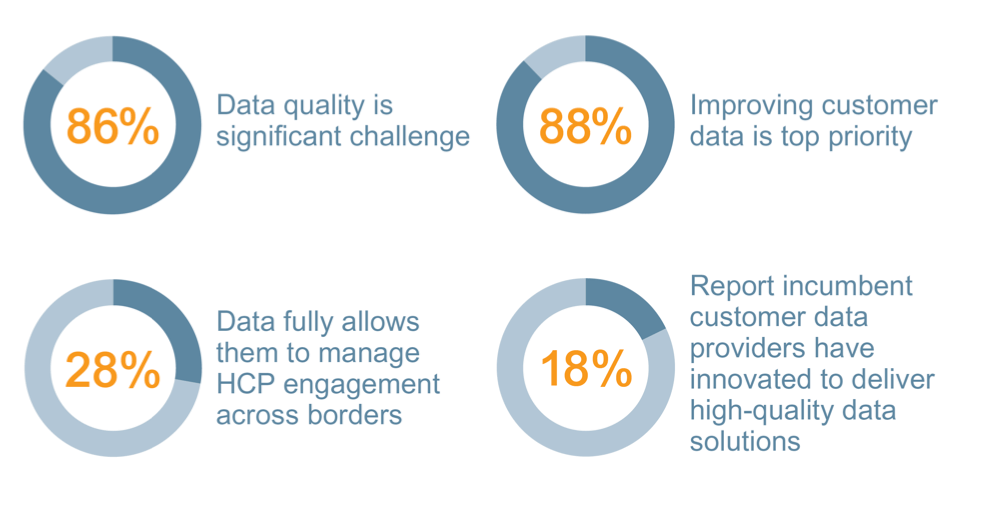Changing Data Trends: Leverage Single Source to Optimize Customer Data Management
Over the past six years, the number of life sciences data providers has shrunk, leaving the remaining providers with little motivation to innovate. Similarly, data technology has remained static, with few providers fully leveraging advances such as the cloud. Meanwhile, life sciences companies are struggling data limitations that prevent them from meeting regulatory needs and effectively interacting with customers. Ultimately, life sciences companies are disadvantaged in reaching their full potential as improvements in the quality of data and services decline.
Customer data is paramount—but quality is a challenge
The disconnect can be seen in the fact that 88% of life sciences executives believe that customer data is a top priority for their organization, and yet 86% believe that data quality is lacking, according to a recent survey results*.

Moreover, the need for consistent, cross-border customer data has never been more urgent. Only 28% of respondents say that current data allows them to fully manage healthcare professional (HCP) engagement across geographies. This global and regional visibility is critical for compliance and transparency.
Clearly, life sciences companies are not getting what they need from their customer data. But that does not have to be the case anymore. Trends in customer data are changing. Data management experts at the 2015 Veeva Commercial Summit described the evolution, referencing three main themes:
Leverage Single Sourcing to Optimize Efficiency and Quality
Reliable and complete customer data is the lifeblood of commercial life sciences, enabling everything from customer engagement to compliance. Selecting a single provider for all kinds of data including compliance data, KOL data, email data and customer data is a prerequisite for a complete and accurate multi-country data with comprehensive HCP tracking. Minimizing the number of data integrations and maintenance greatly improves data quality.
Feel the Need for Speed
Many life sciences companies have simply accepted the status quo: some providers can take a month or more to process Data Change Requests (DCR). But it doesn’t have to be that way. Commercial teams now demand faster DCR response times from their data vendors.
It’s all about agility. Sales reps are working from their mobile devices, looking up HCP profiles and changing call plans on the fly. The faster they can receive DCR updates from their data vendors, the sooner they can efficiently update their call plans for the week. Why not make your data provider accountable for being a partner in data quality over time, suggested experts at the conference.
Predict Future Data Costs
The market now expects to be charged for every single use of the data, taking it from a capital expense to an operating expense.
A simplified, cost-effective data pricing model is needed to ensure predictable budgeting and improve return on investment. With predictability and insight into future data expenditure, commercial organizations can maintain their budget more consistently.
Session attendees also discussed both long-standing challenges, like data accessibility, as well as new breakthroughs. Innovations in data science and analytics, for instance, are now allowing commercial organizations to better engage customers. Vast volumes of data—including information on customer behavior and preferences derived from CRM—are mined to deliver customer-facing teams concrete, actionable recommendations on creating the most effective interaction for a particular HCP. This capability gives clear guidance on the best channels and messages, allowing companies to provide more coordinated, customer-centric experiences.
Data challenges are among the most vexing, and pervasive, in life sciences. Commercial excellence largely relies upon customer information—and improving the delivery and quality of data is a key component of the Veeva OpenData vision.
* Source: Veeva Systems, “European Life Sciences Industry Survey on Customer Data, May 2015“ final results.